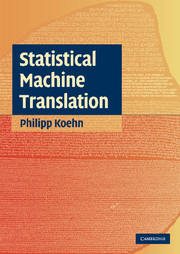1 - Introduction
from I - Foundations
Published online by Cambridge University Press: 05 June 2012
Summary
This chapter provides a gentle introduction to the field of statistical machine translation. We review the history of the field and highlight current applications of machine translation technology. Some pointers to available resources are also given.
But first let us take a broad look at the contents of this book. We have broken up the book into three main parts: Foundations (Chapters 1–3), which provides essential background for novice readers, Core Methods (Chapters 4–8), which covers the principles of statistical machine translation in detail, and Advanced Topics (Chapters 9–11), which discusses more recent advances.
Chapter 1: Introduction
Chapter 2: Words, Sentences, Corpora
Chapter 3: Probability Theory
Chapter 4*: Word-Based Models
Chapter 5*: Phrase-Based Models
Chapter 6*: Decoding
Chapter 7: Language Models
Chapter 8: Evaluation
Chapter 9: Discriminative Training
Chapter 10: Integrating Linguistic Information
Chapter 11: Tree-Based Models
This book may be used in many ways for a course on machine translation or data-driven natural language processing. The three chapters flagged with a star (*) should be part of any such course. See also Figure 1.1 for the dependencies between the chapters. Some suggestions for courses that last one semester or term:
Undergraduate machine translation course: Lectures on Chapters 1–6, and optionally Chapters 7 and 8.
Graduate machine translation course: Lectures on Chapter 1, give Chapters 2–3 as reading assignment, lectures on Chapters 4–8, and optionally Chapters 9, 10, or 11.
Graduate data-driven NLP course: Chapters 2–7 (with stronger emphasis on Chapters 2, 3, and 7), and optionally Chapters 9 or 11.
Information
- Type
- Chapter
- Information
- Statistical Machine Translation , pp. 3 - 32Publisher: Cambridge University PressPrint publication year: 2009
